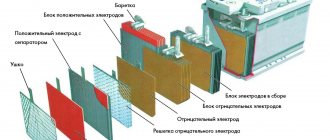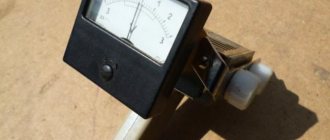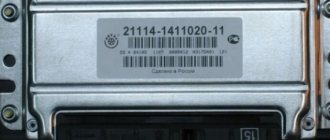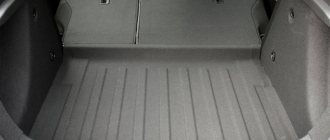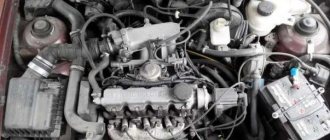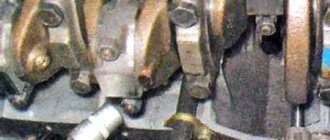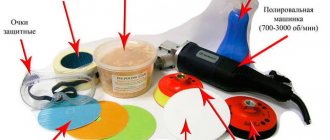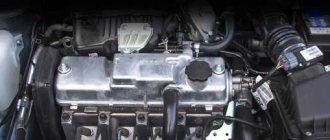How to choose the right battery the first time
Ideally, the best option would be to have your used battery on hand.
Nowadays, auto supply stores are located on every corner, so you can choose the one that suits you best and drive straight to it. Then you will immediately decide on your next purchase. Next, we describe the step-by-step mechanism of action when purchasing a new battery:
It is necessary to accurately determine all technical characteristics (power, capacity, etc.)
d.). Next, you should choose a battery of the same type as the former battery. Particular attention should be paid to the dimensions; you can even literally measure them with a ruler. Be sure to study the terminals. View fastening type. Select the battery by charging method. Battery charging should be normal
Here you can save a little by buying a “dry-charged” battery and charge it at home. All that remains is to carefully inspect the battery for mechanical damage.
To summarize this article, we can say that the size of the battery is one of the main characteristics when purchasing it. If power data is usually found many times and is easily remembered, then the dimensions, shape of the terminals and the location of the power supply are not so easy to remember. By following the instructions that have been disclosed in this text, it will be much easier for you to purchase the right battery for your car.
The article was written based on materials from the sites: www.kolesa-darom.ru, www.akb-market.ru, carsmotion.ru.
Starting current
Batteries TAB Slovenia Blog Which battery is better to buy: gel, EFB or AGM Myths and reality
Another important battery parameter. It determines how confidently the battery will start the engine in any weather, even cold weather.
Manufacturers from different continents use their names in labeling:
- Russian: GOST 959 2002.
- European: EN.
- German: DIN.
- American:
Important! The parameters of the Russian and European standards are identical. If our car enthusiast needs to buy a battery with a starting current of 600 A, then you can choose products marked GOST or EN 600 A
If the German DIN standard is indicated on the battery, you will have to make the following calculations: multiply the indicator behind DIN by a factor of 1.7 to obtain the required value.
When purchasing a battery from an American manufacturer, the number after the SAE abbreviation should be reduced by 5-10%.
Residents of the northern regions of the country are better off purchasing products with a high inrush current. They are more expensive, but there will be no problems with starting in severe frosts.
Marking
The nuances of symbolic designations on the battery depend on the methodology used. Most often this is the European standard ETN (European Type Number), which is officially abbreviated in inscriptions to two letters “EN”. The marking itself consists of a 9-digit number, divided into four zones, sequentially indicating the range and actual capacity, design and 10% of the “cold cranking” current.
Fierce competition in the market has led to manufacturers trying to simplify the procedure for selecting the optimal battery for consumers and duplicating the information on the case in a more understandable form. For example, the Austrian Banner car battery is supplemented with a sticker on which the main characteristics are clearly stated - operating voltage (V), capacity in ampere-hours (Ah), starting current in amperes (A).
Four letters are stamped on the case near the terminal, allowing you to find out the production date. The first two indicate the ordinal week, the last two indicate the year. To convert letter designations into numbers, you should use a special table.
| Letter | The corresponding figure |
| A | |
| B | 1 |
| C | 2 |
| D | 3 |
| E | 4 |
| F | 5 |
| G | 6 |
| H | 7 |
| I | 8 |
| J | 9 |
| K | 10 |
| L | 11 |
| M | 12 |
If EBBF is indicated on the case, this is the 41st week (beginning of October) of 2015, СGBI is the 26th week (end of June) of 2021.
The battery may also contain domestic (according to GOST R 53165-2008), German (DIN), American (SAE) markings. There are differences between them in the interpretation of the magnitude of inrush currents. Without knowing the nuances, it is quite difficult, for example, to buy a Bosch car battery to correctly replace the standard Exide battery in a Ford, Volvo or Honda. (see table).
| Correspondence of cold start current in various standards, amperes | |||
| EN | DIN | SAE | GOST R 53165-2008 |
| 230 | 140 | 250 | 160 |
| 330 | 200 | 350 | 195 |
| 360 | 225 | 400 | 225 |
| 420 | 255 | 450 | 260 |
| 480 | 280 | 500 | 290 |
| 520 | 310 | 550 | 325 |
| 540 | 335 | 600 | 355 |
| 600 | 365 | 650 | 390 |
| 640 | 395 | 700 | 420 |
| 680 | 420 | 750 | 450 |
| 760 | 450 | 800 | 485 |
The canceled domestic standard GOST 959-91 corresponded to DIN. The current GOST R 53165-2008 is focused on the international standards IEC 60095-1:2006.
Terminal dimensions
Lithium-ion Li-ion batteries and batteries
The size of the battery does not correspond to the size of its terminals, so when choosing a power source you should also pay attention to them too. Standard for most cars is a diagonal arrangement of current leads.
Which battery to choose?
The overwhelming majority of European and domestic power supplies have terminals that look like posts. They can differ in diameter (the positive terminal is always larger than the negative terminal!), there are standard and smaller diameters. Standard terminals can also be found on Asian cars, specifically Japanese ones. In Europe and Russia, terminals with a smaller diameter are more common.
It is worth noting that there are also terminals of other sizes on the market, such as: screw, bolt-on, flat-angle and others
When choosing a battery, it is much easier to pay additional attention to the terminals than to subsequently replace the supply contacts
Other battery sizes that influence its choice
Other important characteristics that affect the ability to install and quickly connect the battery to the on-board network are the location of the terminals and their size. The first parameter reflects the relative position of the battery terminals relative to its body. Main types:
- straight polarity – “plus” on the left, and “ground” on the right;
- the opposite is the opposite.
When determining the polarity, the battery should be turned with the front side (with the label) towards you. If you choose a battery with a polarity that is not provided for by the design of the car, you may encounter a situation where the wires for connecting the on-board network are not long enough (both or only one). In this case, you will have to extend the cables, which in principle is not difficult, but is undesirable.
There are also batteries with a combined arrangement of terminals: diagonally; in the middle along the long side of the battery housing. These usually fit all cars of the corresponding standard. And American standard batteries: with direct and reverse polarity.
The size and shape of car battery terminals are also different, which can significantly complicate the process of connecting the battery to the on-board network. Domestic and many imported cars are equipped with batteries with terminals in the form of a column and the contacts of the wires of the electrical network of the car corresponding in size and shape to these terminals. These battery terminals differ from each other - the diameter of the “ground” is slightly smaller than that of the “plus”. In addition, “post” contacts are divided according to their diameter into standard and small. The latter are usually found on Japanese cars, while the standard ones are more familiar from domestic cars. There are also batteries with other types of terminals: bolted, screw, in the form of a flat angle with bolt fastening. If you don’t pay attention to the shape and size of its terminals when choosing a battery, you will eventually have to change the contacts on the connecting wires of the car’s electrical network.
Another important dimensional parameter of the battery is how well its dimensions correspond to the standard fixing mount for it. Of course, many people drive without securing the battery at all, but simply by placing it in the battery socket (niche). The weight of the battery and the plus of the suspension ensure the relative stability of the battery and the safety of its operation. However, the inevitable vibrations and “bouncing” on potholes are unlikely to help extend the life of car batteries. In addition, in the event of any emergency, it is not known where and in what condition the loose battery and its acid will end up. Therefore, it is better to first measure either the dimensions for fastening the “native” battery, or the contours and shapes of the fastening itself.
Capacity
Men's siteRecovery of metal hydride batteries
This is the main operating characteristic of the device. The unit of measurement is ampere/hour (Ah).
Advice! It is necessary to select the battery according to the recommendations of the manufacturer of this car brand, which in turn is guided by the engine size located on this car.
Buying a device with a lower value will not bring any benefit: the battery is simply not enough for the normal functioning of the car network or to start the engine. Purchasing a battery with a larger capacity is not economically justified. It will cost more, but the effect will not increase.
Let us remind you about labeling.
For example, the designation 6ST-60 says the following:
- number 6 – the product consists of 6 cans;
- ST – battery type: starter;
- 60 is an indicator of energy charge, or simply: capacity.
The abbreviation behind the last numbers tells about the material used to make the battery.
Sizing
For unification and better interchangeability, car battery manufacturers standardize overall dimensions by capacity and region of sale. If you do not know the battery model in advance, before purchasing it is advisable to measure the length and width of the installation area with a tape measure. Be sure to evaluate the approximate location of the current terminals, at which it will be possible to easily connect the terminals. You can reliably find out the standard size from the repair and operating manual for your car model.
Forward and reverse polarity
The concept of polarity determines the location of the current terminals. To determine it, position the battery so that the side where the terminals are installed is facing you.
- Straight polarity (European standard). It is marked on the body with the letter R.
- Reverse polarity. It is marked with the number 1 or the letter L.
24 V batteries that power the on-board networks of buses and trucks have a different terminal arrangement.
Polarity is one of the main parameters when choosing a car battery. The positive wire and the ground wire on the car have a limited length. Therefore, there is a risk that in case of an erroneous choice, organizing the engine compartment near the site will not allow connecting the battery.
Form of current leads
The shape is determined by the region where the car is sold. Among the most common:
- Asian type of batteries (it is also the Japanese standard, so it is found on Toyota, Honda, Nissan, etc.). The main feature is that the current terminals protrude beyond the upper boundary of the battery case;
- European standard. The current leads are recessed, so they do not stick out above the body. Installed on Volkswagen, BMW, Skoda, VAZ and many other European cars.
There is also a non-standard design, in which, for example, the terminals are screwed into the current terminals on the side of the battery.
Mounting, ventilation
Car batteries are either screwed to the installation site with a cross member from above, or fixed in a special clamping bar. To be mounted with a strap, the battery case must have a special molding.
If the battery is installed in the luggage compartment, under the seat, we recommend choosing a battery with a single gas outlet. The manufacturer provides a ventilation hole into which a tube is inserted to remove toxic fumes from the electrolytic fluid.
MUTLU BATTERY › Blog › Standard sizes of passenger car batteries
In the world of batteries, standardization has not yet reached absolute levels. The three main regional standards have not yet been replaced by a single global one. Today on the market you can find batteries with the same capacity and current, but they will be radically different in appearance. The terminals, sizes, and types of battery fastenings may be different. Today, three types of battery performance standards are in force simultaneously - European ETN, Japanese (Asian) JIS and American SAE.
The physical size of a battery is directly affected by its required capacity - a high-capacity lead-acid battery is simply physically impossible to make smaller than a certain size. Based on external dimensions, batteries are often divided into two types: European/American and Asian. The latter, as a rule, have a smaller width and length, but a greater height. This is historically dictated by the fact that in the early Japanese automobile industry, when the bulk of the cars were kei cars, a dense layout of the engine compartment was adopted and the batteries were narrow but tall. European and American types of batteries, on the contrary, are more squat, but wide and long.
Asian batteries from all manufacturers usually have a size index corresponding to the Japanese industrial standard JIS. For 12 V passenger car batteries, these are letters from A to H (denoting width and height) with two numbers indicating the length of the battery in centimeters (for example, D26, B24).
European batteries always have a width of 175 mm, the height of the battery is coded with the letter L (height 190 mm) or LB (height 175 mm), the number from 0 to 6 after L/LB means the length of the battery is from 20 to 41 cm (rounded).
The second difference between battery types depends on the design of the battery terminals. Here the division is also regional - European positive terminals have a standard thickness of 19.5 mm, some Asian ones (frame sizes B19 and B24) have narrow terminals - the positive terminal is 12.7 mm. You can see it clearly here.
American standard batteries may have threaded terminals, sometimes in the form of threaded holes, sometimes with a nut. The terminals on European batteries, as a rule, are recessed into the battery case, while the Asian terminals stick out above the battery level, which is why such batteries are popularly nicknamed “horned”.
The third, no less important design difference is the polarity of the battery, or, more simply, the location of the terminals. Standard polarity involves installing the negative terminal on the right (marked R according to the JIS standard, “0” according to the EN standard), if you turn the battery with the side with the terminals facing the viewer. Reverse polarity, more often found on Asian batteries, means the negative terminal on the left (marked L according to the JIS standard, “1” according to the EN standard). Truck batteries, as well as American car batteries, have terminals on the side, but their polarity may also differ. A visual illustration is here.
The last difference is in the types of sites for mounting the battery on the car. There are also quite a few variations here, depending on the version of the lower battery mount. See the picture at the link.
What could go wrong?
As we can see, there are many standard sizes of car batteries. When choosing a replacement battery, you should start by determining the right size for you - it would be a bit of a shame to buy a battery that simply doesn’t fit into its specifications, wouldn’t it? Polarity plays an equally important role - the length of the wires may simply not be enough, and you will not be able to connect the battery if you make a mistake with the correct location of the terminals. The type of terminals themselves is a little simpler - now there are all kinds of adapters on sale (from thin to thick, from threaded to solid, etc.), but it is worth remembering that such an adapter is a non-standard device that can change the resistance, cause heating of surfaces, etc. etc. Their installation is not recommended by the manufacturer.
Size - battery
The dimensions of the battery are calculated in the same way as for the liquid separator.
| Dimensions and weight of SK type batteries. |
Battery sizes, starting with type SK-16, are in table. 3 - 2 are indicated for wooden vessels.
The size of the batteries is chosen arbitrarily. Considering that the selected batteries have 10 positive plates, it is easier to convert to other battery sizes using the decimal system.
With the battery sizes usually used in SGVS systems, the difference AU is small compared to Q, L, E and can be taken equal to zero.
With the battery sizes usually used in SGVS systems, the difference zlU is small compared to O, L, E and can be taken equal to zero.
| Accumulator with gas-filled chamber (Walter Ernst, Oil hydraulic power and Its industrial applications, p. 258, Fig. 204, McGraw-Hill Book Co., Inc.. 1949. |
Therefore, it is necessary to size the battery according to the installation requirements. The upper pressure limit is set. The minimum allowable pressure and displacement are a function of the load.
| Change in battery charging current over time at a constant voltage of 2-15 and 2-27 V. |
The charging current depends on the size of the battery, its technical condition, electrolyte density and temperature, since these factors determine self-discharge. Experience shows that in order to maintain a battery in a charged state, some constant voltage must be applied to its terminals - the recharge voltage. The required charging current is set automatically depending on the temperature. As the temperature rises, self-discharge increases, while at the same time, at a constant voltage at the terminals, the charging current also increases due to increased diffusion of the electrolyte and a decrease in the polarization emf. Thus, the self-discharge that increases with increasing temperature is compensated by a corresponding increase in the charging current.
The symbol ends with a number characterizing the size of the battery and approximately corresponding to the nominal capacity.
SCA is distinguished by a wide variety of types and sizes of batteries produced in small batches. However, work has already begun on creating mechanized production of SCA.
| Assembly (a fragment of plywood separation (in and a template for installation. |
The number of sticks varies depending on the size of the batteries. To correctly install the sticks, use a special template (Fig. 117 6), consisting of a board with strips nailed at a distance corresponding to the grooves on the extensions of the negative plates. Both side sticks 4 are put on plywood 1 before it is installed in the vessel, and the middle sticks 3 with a slot to the very bottom after its installation. No plywood is placed between the outer plates and the wall of the tank.
The dimensions of silver-zinc batteries are significantly smaller than the dimensions of other types of batteries with equal capacity. The low internal resistance of such batteries makes it possible to obtain higher pulse currents.
What types of car batteries are there?
The most common are lead-acid batteries, which use the chemical reactions of lead dioxide and lead in a sulfuric acid environment. This type of battery can be either serviced (require topping up with distilled water) or maintenance-free (do not require any intervention).
Batteries in sealed cases do not need to be maintained, but due to their design, they have a lower capacity.
The most modern models operate on a gel-like electrolyte. All of them are maintenance-free.
There are also so-called low maintenance batteries. Manufacturers supply them dry-charged or with electrolyte filled at the factory.
If you want to purchase a battery for future use, the best option would be to purchase a dry-charged one, since it has a long shelf life. You can bring it into working condition at any time by filling it with electrolyte.
Batteries filled at the factory are ready for use immediately. For such batteries, the electrolyte is prepared by specialists using high-quality components. They contain many (over 20) additives that prevent sulfation, shedding of the active mass, etc.
It should be noted that special modifiers with such additives, which have recently appeared on the market, do not inspire confidence.
Flooded batteries have one advantage: before they hit the shelves, they are charged using special equipment with controlled parameters.
Significant characteristics when selecting a battery for a car in Perm
The most important of them are the make of the car, the type and size of the engine. All this data is known to every owner. In addition to them, you should clarify:
- Voltage. It can be 12 V or 24 V.
- Capacity, which is expressed in ampere-hours. Its value can be found on the battery itself or in its accompanying documents. It is advisable to choose a battery of the same power. If it is less, it will not be enough to satisfy all the operational needs of the car. It is worth remembering that a device with a larger capacity will cost more.
- Reserve volume. It indicates how long the engine and electrical equipment of the car can operate if the generator fails. First of all, we are talking about the starter, injector, engine control unit and lighting equipment.
- Dimensions. In most cars, the space available for installing a battery is strictly limited. A deviation of even a couple of centimeters can lead to the fact that it simply will not fit into the standard socket. The possibility of a short circuit, dangerous for electrical appliances, cannot be ruled out.
What battery power to choose
For gasoline injection engines, depending on the size of the power unit, you need to choose a battery with the following power:
https://youtube.com/watch?v=HLvFx1FZAsU
- Less than 1.6 liters - 44 Ah
- From 1.6 to 2.5 liters - 55 Ah
- From 2.5 to 3 liters - 55 Ah
- From 3 to 3.5 liters - 75 Ah
- More than 3.5 liters - 90 Ah or more
For diesel engines the numbers will be as follows:
- Less than 1.5 liters - 55 Ah
- From 1.5 to 2.0 liters - 62 Ah
- From 2.0 to 2.7 liters - 75 Ah
- From 2.7 to 3.5 liters - 90 Ah
- From 3.5 to 6.5 liters - 132 Ah
- More than 6.5 liters - 190 Ah or more
Although carburetor engines are slowly living out their lives, and there are fewer and fewer cars with such a system every year, they are still quite frequent guests on the roads of the CIS countries, so we will give figures for them:
- Less than 1.2 liters - 44 Ah
- From 1.2 to 1.8 liters - 55 Ah
- From 1.8 to 2.5 liters - 66 Ah
- From 2.5 to 4.5 liters - 75 Ah
- From 4.5 to 6.2 liters - 90 Ah
- From 6.2 to 8.0 liters - 132 Ah
It is also worth paying attention to the number of electronic systems in your car. If it is a business or premium class, it is worth taking a battery with an additional 10-15 Ah - in such cars they will definitely not be superfluous
https://youtube.com/watch?v=UMLraOKb-Fk
In addition, be sure to study the technical documentation for your car - the manufacturer must stipulate the recommended battery capacity there. Whatever battery you choose for your car, its parameters must be no lower than those specified by the factory.
How much does a car battery weigh 60
For cars, starting cars are used, which are 2-3 times lighter than traction cars. They work differently. The starting battery will give off energy in one gulp to start the engine, and then will be recharged. Traction batteries operate on one charge, gradually losing capacity, until the next recharge from the network.
How much a 60 amp car battery weighs depends on the manufacturer. It often happens that the declared weight does not coincide with the actual weight. This means the manufacturer has made a change to the thickness of the lead plates. Let's take the standard size of car batteries with a capacity of 60 A*h. The average weight of a battery with electrolyte should be 15.4 kg, dry - 13.3. They contain the same amount of liquid - 2.2 liters, and the weight of models from different manufacturers:
- Tilan - 15.2 kg;
- Tyumen Bear – 15.0 kg;
- Forse – 15.5 kg;
- Banner – 16.5 kg;
- Bost – 16.2 kg.
The battery capacity is determined by the amount of active mass on the grid and the volume of electrolyte. For strength and ability to restore capacity - the thickness of the lead plates. Which battery to choose from those considered is up to you to decide.
When does the battery need to be replaced?
In the life of every car enthusiast there is a situation when his “native” battery begins to fail its owner. It starts to be “capricious”: it won’t start the first time, or it may even not start the engine at all.
This often happens in cold weather. Agree, it’s not very pleasant: running around with your neighbors with a cigarette lighter asking for help to start the car. Other options for solving a deadlock: find a person who agrees to “pull” the car on a cable or “push” it down a hill.
In addition to these cases, a faulty battery makes itself known in the following ways:
- the on-board computer display displays a request to charge the device;
- the voltmeter shows a low charge level, even after intense movement;
- a foreign musty smell appears from the battery;
- low density level in one of the cans;
- The battery does not charge to the required level even with the charger.
Some models have a peephole - an indicator with which you can determine the electrolyte level in the device.
Car battery sizes
Unlike weight, the size of a car battery must be the overall dimensions when purchasing it. Battery sizes do not exist on their own and are not pulled out of thin air by manufacturers. In many ways, they are determined by the main parameters that characterize the operation of the battery: capacity and starting current. The higher these indicators are, the more electrodes and the volume of active mass are required. Accordingly, the size of the battery case increases
Surely everyone has noticed that batteries for trucks with large capacities are larger in size than those for cars. Precisely because they contain more plates in their composition
European size
European standard battery sizes are suitable for use in European and domestic vehicles. In appearance, they can be immediately distinguished by the terminals recessed in the battery cover.
Asian size
The dimensions and appearance of an Asian battery are noticeably different from European ones. The battery terminals are flush with the plane of the cover, and the body itself has a greater height and shorter length
Please note that most cars from Asian manufacturers have exactly these batteries. In addition to differences in size, these batteries are mounted differently in the engine compartment.
For the European type, the fastening is carried out by the protrusion at the bottom of the battery case, and the Asian type battery is pressed with a bar on top using screw clamps. Therefore, you need to buy a battery with dimensions and type similar to the old one. Otherwise there will be problems with the installation.
American size
The North American battery is similar in size to the European type, but has different dimensions. They are located on the side of the long side of the battery. The terminals have internal threads and the terminals are attached to them using bolts. This design is used on vehicles that are supplied to the North American market. In Russia, batteries of this type are not very common.
Below you can see a table where batteries with different capacities are collected. Perhaps it will help you navigate when choosing a battery.
| Length x Width x Height, mm | Standard size | Capacity, Ah |
| Length x Width x Height, mm | Standard size | Capacity, Ah |
| 187x127x227 | Asia | 35 |
| 187x127x227 | Asia | 40 |
| 175x175x190 | Euro | 42 |
| 207x175x175 | Euro | 44 |
| 238x129x227 | Asia | 45 |
| 207x175x190 | Euro | 52 |
| 242x175x190 | Euro | 60 |
| 232x173x225 | Asia | 60 |
| 242x175x190 | Euro | 60 |
| 242x175x175 | Euro | 61 |
| 242x175x190 | Euro | 62 |
| 242x175x190 | Euro | 63 |
| 232x173x190 | Asia | 65 |
| 261x175x220 | Asia | 70 |
| 278x175x175 | Euro | 72 |
| 278x175x190 | Euro | 74 |
| 278x175x190 | Euro | 77 |
| 315x175x175 | Euro | 80 |
| 353x175x190 | Euro | 95 |
| 306x173x225 | Asia | 90 |
| 306x173x225 | Asia | 95 |
| 353x175x190 | Euro | 100 |
| 390x175x190 | Euro | 110 |
| 513x189x223 | Euro | 140 |
| 518x240x242 | Euro | 180 |
| 518x240x242 | Euro | 200 |
| 518x240x242 | Euro | 225 |
Battery sizes and data tables
In this section we present the basic digital data characteristic of each standard in the production of rechargeable batteries for cars. The dimensions of car batteries will also be presented, table 1, 2, 3, 4.
European assembled batteries
In Europe, batteries are produced that have the following capacitance characteristics - from 40 to 225 Ah (ampere hours). Battery sizes are divided into 2 groups:
- Batteries with capacities of 40 – 70 Ah have the following dimensions:
- Width – 174 mm.
- Height – 174 or 189 mm.
- Length – 174 – 241 mm.
- Batteries with capacities of 70 – 225 Ah have the following dimensions:
- Width – 174 – 239 mm.
- Height – 174 – 241 mm.
- Length – 277 – 517 mm.
Asian assembled batteries
In Asia, batteries are produced that have the following capacitance characteristics - from 35 to 120 Ah (ampere hours). They are divided into 2 groups:
- Batteries with capacities of 35 – 70 Ah have the following dimensions:
- Width – 126 – 174 mm.
- Height – 189 or 226 mm.
- Length – 186 – 260 mm.
- Batteries with a capacity of 90 – 120 Ah have the following dimensions:
- Width – 174 mm.
- Height – 224 mm.
- Length – 305 mm.
It is worth noting that the American standard is completely identical to the European one. The selection of a battery in this segment can be done by studying tables 1 and 2. Changes in the design of these batteries may depend on the terminals.
Modern battery standards
Currently, battery sizes are strictly regulated by generally accepted quality standards. We list their main types:
European standard
It is used to produce batteries intended for use in European and our Russian cars (in this case, you should pay attention to the polarity of the terminals, it is usually the opposite). North American standard. The current leads on these batteries are located in the upper part on the side of the housing cover (unlike other batteries, in which the current leads are located along the long side)
The terminals on these batteries are made with internal threads, so finding a similar copy on the Russian market will be very difficult. Most likely, you will have to order the battery directly from the USA, if necessary. Asian standard. The sizes of batteries from Asian manufacturers are fundamentally different from European sizes. Cars produced in Asian countries have much less space under the hood compared to other cars. All engine compartment equipment and the engine are very tightly packed. Asian batteries are much shorter and narrower than competitors, but significantly higher than them.
The dimensions of car batteries may depend not only on the standard, but also on the country of origin. For example, Asian power supplies that are manufactured in Europe for its market may have dimensions similar to European ones. In any case, before purchasing a new power source, you should always carefully study the engine compartment of your car and all the technical nuances associated with its further installation.
paly478 › Blog › How to choose a battery for a passenger car?!
MAIN SELECTION CRITERIA:
Practice shows that increasing the capacity of a car battery is advisable only up to a certain limit. A battery with a capacity many times higher than that recommended by the manufacturer will not give a visible effect and will only become an additional expense for the owner. Elementary, the battery may simply not have time to charge completely, which will lead to its rapid “death.”
The best option is to install a battery with a capacity recommended by the car manufacturer, or exceeding it by 5 - 10A.
Overall dimensions of the battery
If you purchase a battery of inappropriate sizes, installation will be very problematic, and may even be impossible. For this reason, before purchasing a new battery, it is necessary to measure the seat as accurately as possible and select a battery with minimal deviations in size.
Polarity
Before you buy a battery, you should find out the correct polarity so that you don’t have any difficulties installing it later.
A simple car battery has the most common current output patterns: direct and reverse polarity. There are specific ones, but we have almost none of them in our country, so we will not consider such schemes. I would like to immediately draw your attention to the fact that if you make a mistake when choosing the polarity, you will not be able to use the battery - the pole wires will not reach the terminals.
Determining the polarity on your car is EASY!
Batteries with a capacity of up to 110 a/h have current leads on the long side. There is one nuance here - the battery has two long sides, and the terminals are located a little closer to the edge of one of them. It is this side that you need to turn the battery towards you.
There are "+" and "-" markings on or near the terminals to indicate the corresponding poles. If the + terminal is on the right, then it is a battery with reverse polarity. If the “+” is located on the left, the battery has straight polarity.
On vehicles produced in our country, batteries are installed with straight polarity. In addition, many Chinese cars and some cars made in Japan have straight polarity. Almost all European cars come with reverse polarity.
Battery mounting type
There are two options - upper and lower versions. The differences between them are the presence/absence of special side protrusions (bottom mount). When purchasing a battery with a bottom mount, you should pay attention to the presence of protrusions, since if they are missing, attaching the battery will be impossible.
Starting current and reserve capacity
1) Starting current
The maximum value of the starting current affects the crankshaft rotation speed and, as a result, faster engine starting. Modern batteries for passenger cars have several types of markings for this parameter, which depend on the test standard (EN, DIN and others) and may look like, for example, 510A (EN) or 300A (DIN). Unlike the battery capacity, the increase of which plays a role only up to a certain limit, the starting current in all cases of increase only has a positive effect on the quality of engine starting.
2) Reserve capacity
The reserve capacity of the battery shows the time during which the battery can supply the electrical system of your car with a current of 25 A when the generator is not working, that is, how much time you have to get to the service center with a broken generator in the dark. It is measured in minutes and designated by the letters RC (Reserve Capacity).
Car battery cost
Today, the market offers a huge number of batteries of various price categories that can meet the needs of car owners with any budget.
It is important to understand that a car battery store that offers a selection strategy “expensive means good” is not objective; cost is not always the primary factor and often becomes the reason for wasting money.
Summarizing the criteria for choosing a car battery, it should be noted that there are no ideal product characteristics; each car enthusiast has his own set of requirements and preferences. The parameters proposed by the battery manufacturer are considered optimal, however, as practice shows, increasing some of them can only have a positive effect on the performance characteristics of the car.
Source
Flooded and dry-charged battery
The positive thing about purchasing flooded batteries is that the battery is sold in a condition suitable for immediate use. The buyer does not need to buy electrolyte and pour it into the battery. It should be taken into account that when filling batteries, the manufacturer uses the highest grade electrolyte, containing the minimum permissible amount of impurities, while the quality of the electrolyte sold is often very questionable. In addition, the quality of a filled and charged battery can and should be carefully checked when purchasing it, while the quality of a dry-charged battery can only be determined after it has been activated according to the attached instructions. The only advantage of dry-charged batteries is the possibility of long-term storage (3-5 years) without changing their basic properties, except for the loss of dry-charge capacity after the first year of storage. A dry-charged battery is not ready for immediate use. It requires pouring electrolyte and impregnation (from 0.3 to 1 hour), followed by charging (possible by car) until the density of the electrolyte in all cells is equal to the density of the filled electrolyte. After storage for more than one year, the charging time after filling and soaking the electrolyte will not be 3-4 hours, as in the first year of storage, but will increase to 6-10 hours.
Manufacturing technology
Lead-Acid (Wet). Liquid lead-acid batteries are most often used as batteries for cars. The positive and negative plates are immersed in a liquid electrolytic composition. A.G.M. Unlike LGC batteries, in AGM batteries the sulfuric acid solution is absorbed by fiberglass cloth. Such batteries are extremely vibration-resistant and can operate in any position. They are recommended for installation in motorcycles, ATVs or cars participating in jeep trial competitions. AGM batteries should also be chosen for cars with the Star-Stop system and powerful audio systems. Due to the low internal resistance of the battery, even with a significant discharge it provides a good starting current. Compared to liquid lead-acid batteries, AGM batteries withstand deep discharges better and therefore have a longer service life. The only disadvantage is, perhaps, the relatively high price. EFB (Enhanced Floded Battery). Batteries use electrolyte in a liquid aggregate state, but the plates with a large amount of purified lead are sealed in a kind of envelope. EFB technology allows you to slow down the rate of oxide deposition, which makes the car battery resistant to deep discharges and extends its service life (with proper operation it can reach 7-9 years). This is the best battery to choose for a car with the Star-Stop system. Oddly enough, EFB batteries are cheaper than AGM batteries. Therefore, if you are not satisfied with the characteristics of Lead-Acid batteries, then it is better to choose Enhanced Floded Battery. GEL. The design of gel batteries allows them to be used only as power sources for motor boats and autonomous power supply for powerful audio systems
Gel batteries have a large capacity, but are not capable of delivering good starting current, which is extremely important for starting the engine in winter.
Low-oxygen, hybrid, calcium batteries
Sb/Sb – marking of low-voltage batteries. The obvious advantages include low cost. If you happen to choose such a battery, you will have to put up with high self-discharge and constantly monitor the density of the electrolytic fluid. If you do not periodically maintain a low-voltage battery, a critical drop in the electrolyte level will lead to exposed plates and a significant reduction in battery life.
Sb/Ca – hybrid car batteries. In all operational characteristics they are superior to low-oxygen batteries.
Ca/Ca – calcium batteries. The active mass of the plates contains a large amount of calcium, which slows down the rate of self-discharge and water evaporation. If you want to choose a car battery with the longest service life, we can recommend a calcium battery. But be prepared to pay a higher price compared to low-voltage and hybrid batteries with similar starting current and capacity.
Which is better: serviced or unserviced?
If the choice of battery is between Lead-Acid and EFB, it is better to refrain from purchasing a maintenance-free battery. But this is by no means the main parameter when selecting. After all, modern calcium batteries have such a low tendency to evaporate water that even without maintenance they are able to start the engine properly for many years. But we recommend serviced batteries for the reason that if the generator relay-regulator malfunctions, you will not have the opportunity to correct the consequences of overcharging.
Capacity, starting current
The description of car batteries indicates the cold cranking current. The higher the TCP, the longer the battery can power the car starter at low temperatures. 3 measurement standards are considered generally accepted: DIN 43559 (GOST 959-91), EN 60095-1 (GOST 959-2002), SSA J537
To choose the right battery, pay attention to the ratio of parameters of different measurement standards. There is no clear relationship between capacitance and starter current, but it is possible to roughly estimate the ratio
Battery capacity indicates how long the battery takes to discharge for a given current draw. The table shows the approximate ratio of the minimum battery capacity to engine size. But in order to choose the right new battery, we recommend that you refer to the repair and operation manual.
Basic selection options
To choose a battery for a passenger car and not regret it, use these recommendations.
Capacity
The “Technical Specifications” for a specific brand indicates the recommended battery capacity. This indicator depends on the size and type of engine.
For passenger cars and crossovers with an engine capacity of up to 2 liters, the capacity ranges from 45 to 66 Ah. For SUVs and diesel cars with an engine capacity of more than 2.5 liters, a battery with a capacity of 65-75 Ah is needed.
You can install a battery with a capacity 30% larger than the standard one (to have a reserve of energy, for example, in a frosty winter). And this will be the best capacity of a car battery. But the dimensions of the battery must correspond to the standard one so that the battery fits freely in the compartment.
It is dangerous to install a battery with a smaller capacity, as it may not have enough charge when starting the car. This is especially true in cold weather and when there is a heavy load on the on-board network (powerful audio system, additional lighting, climate control equipment).
By the way, a battery with a larger capacity will last longer.
Starting current parameters
The higher this indicator, the greater the chances of starting a car in winter. In severe frosts, an extra 100 A can be decisive.
For passenger cars, the starting current (cold start current) ranges from 480 to 650 A, for large SUVs - 800 A.
It is wiser to choose a battery with a high starting current. The higher the better. However, such batteries are usually significantly more expensive. The starting current of the new battery must be no less than the declared one.
By the way, when comparing batteries from different manufacturing countries, keep in mind that there are different marking systems (SAE, DIN, EN). For example, 550A SAE is equal to 520A EN and 310A DIN.
Type
Battery types:
- Calcium. The most common type. No maintenance required. They have high capacity and inrush current. When using them, you should be wary of strong discharge, since it is recommended to change them after 3-4 discharge cycles. They do not tolerate temperature changes well.
- Hybrid. The demand for them is low, since their characteristics are weak.
- EFB batteries. Resistant to deep discharges. They have a long service life. They are expensive.
- Gel and AGM. Expensive, high quality, reliable. They are used on prestigious foreign cars.
- Alkaline. They tolerate overcharging well, but have large dimensions, so they are used for trucks.
Serviceability
Battery models are divided into:
- serviceable (by unscrewing the plug with the cross, you can add electrolyte to them and visually check its condition); have a long service life (up to 8 years), but there is a danger of electrolyte leakage and, as a consequence, failure of the battery;
- maintenance-free (do not require topping up, there is no possibility to fill and check the density of the electrolyte).
Maintenance-free models are easier to use, but more expensive. Serviced models are cheaper and more durable (if used carefully), but require attention, maintenance skills and special equipment (for example, for recharging).
Fastening
It is recommended that the battery be attached to the body. This can be done using a bracket or bracket.
Before installing the battery you must:
- clean the installation site;
- in case of installing a battery with dimensions larger than the standard model, check the correct placement: there is free space for battery ventilation, there are no kinks in the wires, the terminals should not rest against the hood;
- if necessary, clean the terminal contacts;
- check the location of the plus and minus terminals;
- add “plus” first, then “minus”.
After installation you must:
- start the engine and check the performance of the battery;
- treat terminal contacts to prevent corrosion.
Polarity
Batteries come in direct (on the cover “plus” on the left, “minus” on the right) and reverse (vice versa) polarities.
When buying a new battery, you need to choose the type that was in the old battery.
When connecting the battery, it is important not to reverse the polarities. However, it is difficult to get confused here. To minimize risks, manufacturers made the battery leads and terminals different in diameter (19.5 mm for “plus” and 17.9 mm for “minus”).
By the way, owners of American cars should be very careful when choosing a battery. There is a possibility that European battery models will not be suitable for their cars.
Dimensions
When choosing battery sizes, it is better to stick to the standard dimensions of the car manufacturer. However, if you plan to purchase a more powerful battery, its dimensions may not coincide with the standard ones. Slight deviation in dimensions is allowed. In this case, before installation, you must ensure that:
- the battery is freely placed in the mounting socket,
- the terminals do not rest against the hood,
- The wires are long enough
- There is space left for battery ventilation.
Also, when choosing a battery, it is worth considering the country of origin. For example, Japanese and Korean batteries are tall and narrow; American batteries have a different terminal arrangement and wire length.
date of manufacture
Indicated on the battery case.
Russian manufacturers use the simplest system - a code in the “HHMMYY” format.
For foreign brands, everything is much more complicated. They use abbreviations to indicate the year, leaving 1 or 2 digits for the year; for months - alphabetic expressions or numbers in the range from 17 to 60. Encrypted date designations for each manufacturer have to be dealt with separately.
When choosing a battery, be sure to check the production date and storage conditions (heated or unheated warehouse). The fresher the battery, the longer it will last. It is recommended to purchase batteries within six months from the production date. The maximum implementation period is 1 year.
Marking
Russian batteries are marked according to GOST 0959-2002. The labeling indicates the main characteristics of the battery:
- number of “cans” (for 12 V this is the number “6”),
- type (mostly “ST” - starter),
- capacity (for example, “55” corresponds to a nominal capacity of 55 Ah),
- standardized letter code for body composition and type.
The case also indicates the polarity, cold start current according to the EN standard, the mass of the battery and the specifications to which this battery corresponds.
The labeling of European brands consists of 9 digits. For passenger cars it starts with “5”. Then the capacity (2 digits) and the battery design code (3 digits) are indicated. It is loaded with the value of the cold cranking current (multiply these 3 digits by “10”). Also on the case, the brand, article number, rated voltage, series and production technology are additionally indicated.
The marking of American batteries is alphanumeric. For passenger cars it starts with “A”, followed by the battery size (2 digits) and the cold cranking current value (3 digits).
Asian models are marked according to JIS standards, but they are difficult to decipher; there are special translation tables for this.
Appearance
Car batteries vary in size, location of terminals, and recesses on the case. But no brand is immune from counterfeits. Counterfeit products can be identified by low price and appearance.
When choosing a battery, you need to pay attention to the quality of the case, the presence of factory markings, compare the label with official sources from the Internet, check the warranty documents.
Manufacturer
According to sales ratings in Russia, the following are considered popular battery brands:
- MUTLU (Türkiye),
- VARTA (Germany),
- Tyumen Battery Plant,
- TAV (Slovenia), Topla brand,
- Exide (USA, Europe) Exide and Tudor brand,
- BOSCH (Germany),
- Banner (Austria).
Dimensions of car batteries standard table
Try installing a car battery intended for a Japanese car on a “European” one. Such an operation is unlikely to be successful. And it's not just about the type of terminals or polarity. Batteries of different standards even differ in size, which will be discussed further.
So, all batteries, based on their overall dimensions, can be divided into three main standards:
Europe. Batteries manufactured for vehicles supplied to the European market.
Asia. Mainly batteries designed for Japanese cars.
America. The batteries used to equip American cars (are practically no different from the European standard).
This factor has a direct impact on the choice of battery, because the dimensions of these standards have significant differences in a number of criteria: width, height and depth.
To determine the correct standard and capacity of the battery for a specific car, you need to have information about the overall dimensions of the previous battery installed on the car. If this is not possible, remove the parameters, including the length and width of the installation tray. With such data, it is not difficult to determine the standard, as well as the battery capacity, using the table below:
Reviews
Nikolai. Murmansk. I purchased a new Bosch s4 silver battery with a capacity of 60 A/h for my fret. The battery turns the starter perfectly in any weather, and during the polar night it provides good visibility on the road, even at low engine speeds.
Grigory. Stavropol. A very good battery for a car is Titan 6 st 60 A/h. You often have to drive your Mazda at night, so increased battery capacity is as necessary as air.
Alexander. Kerch. I have been buying Forse batteries for my UAZ for over 10 years now. Products of excellent quality, including high-capacity models.
How to check before buying
- Assessing the condition of the battery case. There should be no cracks or leaks of electrolytic fluid on it. There should also be no traces of installation on the car (imprints of terminals on current leads, scratches from the crossbar, clamping strip).
- Checking the EMF value with a multimeter. The voltage must be at least 12.6 V.
- Checking with a load fork. Under load, the voltage at the terminals of a working battery should not fall below 9 V. To find out which new battery is better, we recommend choosing several models and conducting a comparison test.
Also, upon purchase, you can measure the density of the electrolyte, which at 20ºC should not be lower than 1.27 g/cm³. A good seller will never refuse you, but to select a good battery, a successful load fork test and measuring the voltage without load is quite enough.
Best before date
Even in an unused state, irreversible chemical processes occur inside the battery, which reduce the service life of the battery.
Information must be applied to the case using laser engraving or embossing. Car batteries are not supplied in a dry-charged state, so the date printed on the case is the only reliable information about the moment of production.
We recommend studying the battery rating in order to select several models and learn how to decipher the markings. There are no general requirements for printing the production date, so manufacturers are not limited in choosing a method for encrypting information about the battery.
